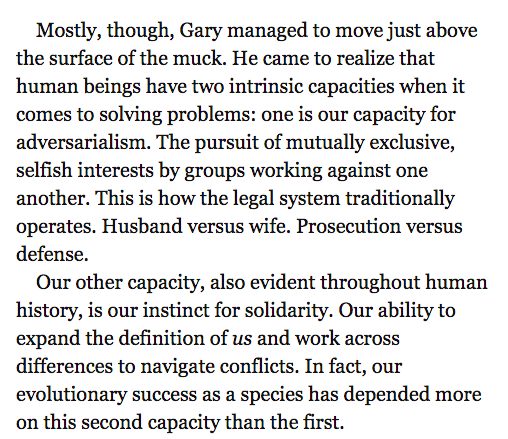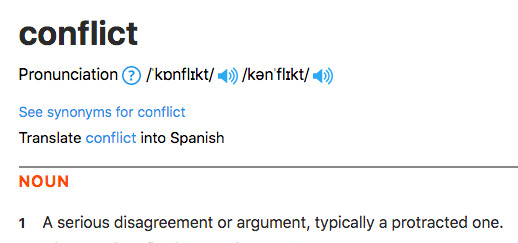1. Cathy’s latest piece covers people who @amandaripley refers to as conflict entrepreneurs in her new book “High Conflict: Why We Get Trapped and How We Get Out”.
https://www.amazon.com/High-Conflict-Why-Get-Trapped/dp/1982128569
(Note:">https://www.amazon.com/High-Conf... Cathy’s piece is no longer paywalled.) https://twitter.com/CathyYoung63/status/1380620433393868801">https://twitter.com/CathyYoun...
https://www.amazon.com/High-Conflict-Why-Get-Trapped/dp/1982128569
(Note:">https://www.amazon.com/High-Conf... Cathy’s piece is no longer paywalled.) https://twitter.com/CathyYoung63/status/1380620433393868801">https://twitter.com/CathyYoun...
2. The woke/anti-woke faction of the current culture war in the US and other Western countries has devolved into high conflict which sounds to me like another term for interactive escalation and mutual radicalization. https://twitter.com/keikoinboston/status/1139361964084355072">https://twitter.com/keikoinbo...
3.
Conflict entrepreneurs: People who exploit high conflict for their own ends.
All definition screenshots are from the glossary in the Kindle sample for “High Conflict: Why We Get Trapped and How We Get Out” by @amandaripley.
https://www.amazon.com/High-Conflict-Why-Get-Trapped-ebook/dp/B08LDW7M7J/">https://www.amazon.com/High-Conf...
Conflict entrepreneurs: People who exploit high conflict for their own ends.
All definition screenshots are from the glossary in the Kindle sample for “High Conflict: Why We Get Trapped and How We Get Out” by @amandaripley.
https://www.amazon.com/High-Conflict-Why-Get-Trapped-ebook/dp/B08LDW7M7J/">https://www.amazon.com/High-Conf...
4. I haven’t been able to find the origin of the term conflict entrepreneur, but found this description from Terrence Lyons, Associate Professor at the Institute of Conflict Analysis and Resolution, from 2002.
https://carnegieendowment.org/2002/02/07/combating-conflict-entrepreneurs-event-453">https://carnegieendowment.org/2002/02/0...
https://carnegieendowment.org/2002/02/07/combating-conflict-entrepreneurs-event-453">https://carnegieendowment.org/2002/02/0...
5. Amanda describes high conflict as a system, not a feeling, and hate as a symptom of high conflict. It happens when people engaged in conflict turn it into a battle between good & evil which can only lead to rigid us v. them thinking.
6. High conflict is universal. Eventually high conflict takes on a life of its own with the people who engage in it trapped in its vortex. https://www.youtube.com/watch?v=J4iRqZd2HYs&ab_channel=Simon%26SchusterAudio">https://www.youtube.com/watch...
7. My thread on how to evaluate one-sided narratives: https://twitter.com/keikoinboston/status/1366562803323174913">https://twitter.com/keikoinbo...
8. This type of us v. them thinking is common in cults. https://twitter.com/keikoinboston/status/1013567718136696832">https://twitter.com/keikoinbo...
9. I relate to this so much.
“It felt like curiosity was dead. What was the point of telling stories in such a time? Of painstakingly reporting and fact-checking every detail, only to be speaking to the same shrinking choice of partisans?”
“It felt like curiosity was dead. What was the point of telling stories in such a time? Of painstakingly reporting and fact-checking every detail, only to be speaking to the same shrinking choice of partisans?”
10. I’ve been increasingly feeling like fact checking is pointless when so many people are incurious and uninterested in knowing what’s real and what’s not. It’s one of several reasons I’ve been tweeting less.
11. Something I’ve often thought when reading one-sided narratives is that the people presenting and amplifying them seem incurious. Why aren’t they asking questions? What aren’t we being told? I ask this question every time I read a one-sided narrative.
12. They jump on the bandwagon because of the storyteller’s reputation or because they see other people they respect amplifying it or because a story bolsters their own beliefs about what’s wrong with the world.
13. It doesn’t matter if the story is fabricated or misleading, as we sometimes learn days, weeks, or months later.
High conflict explains the lack of curiosity.
High conflict explains the lack of curiosity.
14. From High Conflict:
“In normal life, humans make many predictable errors of judgement. In high conflict, we make many more. It is impossible to feel curious while also feeling outraged, for example. We lose access to that part of our brain, the part that generates wonder.“
“In normal life, humans make many predictable errors of judgement. In high conflict, we make many more. It is impossible to feel curious while also feeling outraged, for example. We lose access to that part of our brain, the part that generates wonder.“
15. Cathy highlights the cases of a couple of modern conflict entrepreneurs in her piece and brings in an example from the 1970s/80s to point out that this phenomenon isn’t new. As Amanda says, it’s universal across the world and across time.
16. Cathy also takes the media to task: "Mainstream institutions, including the media, arguably bear some blame for the dissidents’ turn to crankdom. The more they bend the facts to suit narratives and squelch dissent, the more skepticism and contrarianism they breed."
17. @soljourno is hosting a Complicating the Narratives workshop for journalists on Wednesday. Looks like registration is still open. https://twitter.com/soljourno/status/1379775967627862020">https://twitter.com/soljourno...
18. Cathy’s second lesson is that "crackpots do not make good allies”.
No, they don’t, because they’re fire starters (more on this below) stuck in high conflict.
No, they don’t, because they’re fire starters (more on this below) stuck in high conflict.
19. Whatever they’re claiming about the contribution they’re making to society or what a great ally they are to marginalized groups, chances are, the higher the crackpottery quotient, the less effective they are in their claimed aims.
20. Cathy’s piece goes on to cover a couple of other recent examples of high conflict. I’ve written about being damned if you do and damned if you don’t here: https://twitter.com/keikoinboston/status/1267975977327566848">https://twitter.com/keikoinbo...
21. While I think it’s useful for journalists to document the shift that some pundits make from good intentions to conflict entrepreneurship, this road seems well traveled & predictable.
I’m less interested in them than I am in pundits who aren’t taking this more lucrative path.
I’m less interested in them than I am in pundits who aren’t taking this more lucrative path.
22. Is there something intrinsic in those who resist conflict entrepreneurship or is this something that we can all learn? I hope Cathy will do a follow up piece looking at resisters of crackpottery/conflict entrepreneurship and what they can teach us.
23. Amanda makes the case that it’s possible for people to get out of high conflict and move to good conflict also known as healthy conflict.
24. She defines good conflict as “friction that can be serious and intense but leads somewhere useful.
 https://abs.twimg.com/emoji/v2/... draggable="false" alt="🚨" title="Polizeiautos mit drehendem Licht" aria-label="Emoji: Polizeiautos mit drehendem Licht"> Does not collapse into dehumanization.
https://abs.twimg.com/emoji/v2/... draggable="false" alt="🚨" title="Polizeiautos mit drehendem Licht" aria-label="Emoji: Polizeiautos mit drehendem Licht"> Does not collapse into dehumanization.  https://abs.twimg.com/emoji/v2/... draggable="false" alt="🚨" title="Polizeiautos mit drehendem Licht" aria-label="Emoji: Polizeiautos mit drehendem Licht">
https://abs.twimg.com/emoji/v2/... draggable="false" alt="🚨" title="Polizeiautos mit drehendem Licht" aria-label="Emoji: Polizeiautos mit drehendem Licht">
Also known as healthy conflict.” (emojis mine)
Also known as healthy conflict.” (emojis mine)
25. High conflict plays into humans’ natural instinct for adversarialism but Amanda points out that solidarity is also a human instinct.
26. I’ve observed that many people claiming to advocate for a cause or even just trying to make claims about themselves seem more often to shoot themselves (or their cause) in the foot by communicating ineffectively.
27. We see the same shitty behavior all over the political spectrum—ad hominem attacks, shaming, lying, yelling.
When things really escalate we see doxxing, swatting, assault, and murder.
When things really escalate we see doxxing, swatting, assault, and murder.
28. In some recent research on personality disorders I came across an interview clip with Dr. Marsha Linehan, who developed dialectical behavior therapy (DBT), a psychotherapeutic approach to treating people with borderline personality disorder (BPD). https://en.wikipedia.org/wiki/Dialectical_behavior_therapy">https://en.wikipedia.org/wiki/Dial...
29. The first group of skills she teaches patients are mindfulness skills. People with BPD often struggle with the need to be right (even when wrong) and she feels that mindfulness helps to teach them how to be effective in getting their needs met.
30.
“Effectively means doing what works and giving up having to be right all the time.
So it’s instead of being right, being effective.”
—Dr. Marsha Linehan https://www.youtube.com/watch?v=PCJ0R6vAUnw&ab_channel=BorderlinerNotes">https://www.youtube.com/watch...
“Effectively means doing what works and giving up having to be right all the time.
So it’s instead of being right, being effective.”
—Dr. Marsha Linehan https://www.youtube.com/watch?v=PCJ0R6vAUnw&ab_channel=BorderlinerNotes">https://www.youtube.com/watch...
31. Since watching this video I can’t stop thinking about it when I see people online who want to be right not effective. I’ve been wondering if we need mass DBT.  https://abs.twimg.com/emoji/v2/... draggable="false" alt="😂" title="Gesicht mit Freudentränen" aria-label="Emoji: Gesicht mit Freudentränen">
https://abs.twimg.com/emoji/v2/... draggable="false" alt="😂" title="Gesicht mit Freudentränen" aria-label="Emoji: Gesicht mit Freudentränen">
32. Amanda tells the story of Mark Lynas, an environmental activist who was stuck in high conflict for many years before getting out. Doing so helped him to become more effective.
33. I increasingly hear from friends and folks on Twitter who are interested in and sometimes very concerned about culture war issues but dismayed at the growing polarization and crackpottery of some high profile people they used to respect.
34. I really dislike the term “culture war” as it’s a bad starting point for trying to reach across divides to find common ground & common humanity. Framing the situation as “war” is adversarial. But I still use it sometimes because I haven’t come across a good alternative.
35. I’m not sure I like the term good conflict/healthy conflict either. Conflict is defined as: “a serious disagreement or argument, typically a protracted one.”
Words like conflict, disagreement, and argument all have negative, adversarial connotations.
https://www.lexico.com/definition/Conflict">https://www.lexico.com/definitio...
Words like conflict, disagreement, and argument all have negative, adversarial connotations.
https://www.lexico.com/definition/Conflict">https://www.lexico.com/definitio...
36. We can have differences of opinion without the focus needing to be on “sides”. In some cases those differences of opinion come from the fact that people have different lived experiences and different pieces of the puzzle.
37. @BretWeinstein and Brittany King ( @KingTalissa) did a great job modeling this type of conversation which I hope we’ll see more of. https://www.youtube.com/watch?v=j3nuTSMUK-8&ab_channel=BretWeinstein">https://www.youtube.com/watch...
38. @BretWeinstein also recently talked to @IrshadManji, founder of the Moral Courage Project which teaches diversity without shaming and shows students how to be effective in creating change.
https://moralcourage.com/ ">https://moralcourage.com/">... https://www.youtube.com/watch?v=8L9uFRAvrGI&ab_channel=BretWeinstein">https://www.youtube.com/watch...
https://moralcourage.com/ ">https://moralcourage.com/">... https://www.youtube.com/watch?v=8L9uFRAvrGI&ab_channel=BretWeinstein">https://www.youtube.com/watch...
39. Jump to 1:47:50 for an anecdote from her forthcoming documentary “Mississippi Turning”.
See the trailer here: https://vimeo.com/499985349 ">https://vimeo.com/499985349...
See the trailer here: https://vimeo.com/499985349 ">https://vimeo.com/499985349...
40. I’ve only read the Kindle sample so far but “High Conflict: Why We Get Trapped and How We Get Out” looks really timely and I would recommend it to anyone who knows we have to get out of this morass but can’t see a way out.
41. Interview with Amanda and link for book launch event on Tuesday. https://thewholestory.solutionsjournalism.org/theres-another-way-to-do-conflict-a-book-release-chat-with-amanda-ripley-ee21b38c6518">https://thewholestory.solutionsjournalism.org/theres-an...
42. Review of “High Conflict: Why We Get Trapped and How We Get Out” from @YaschaMounk.
Archive: https://archive.is/jknIQ ">https://archive.is/jknIQ&quo... https://twitter.com/amandaripley/status/1380646220507537409">https://twitter.com/amandarip...
Archive: https://archive.is/jknIQ ">https://archive.is/jknIQ&quo... https://twitter.com/amandaripley/status/1380646220507537409">https://twitter.com/amandarip...
43. As Yascha points out in his review, Amanda says that part of moving away from high conflict is to “marginalize the fire starters” (or in Cathy’s language, the “crackpottery”).
44. I’ve written about this before, referring to conflict entrepreneurs as fearmongers. Someone once told me that we choose our leaders. Let’s not choose conflict entrepreneurs who profit off of dehumanization of “them”. https://twitter.com/keikoinboston/status/1088967472257085441">https://twitter.com/keikoinbo...
45. If you can’t afford the book, you can check to see if your library has a copy and if not, you can request that they purchase one (look for link on their website).
https://www.worldcat.org/ ">https://www.worldcat.org/">...
https://www.worldcat.org/ ">https://www.worldcat.org/">...
46. Notes: Some people may find the book’s structure hard to follow. It moves between the stories of multiple people in different places and sprinkles information about high conflict and good conflict throughout.
47. Also, if reading is challenging or you prefer to listen to books, “High Conflict” is also available on Audible, read by Amanda.
https://www.audible.com/author/Amanda-Ripley/B001JS0LS8">https://www.audible.com/author/Am... https://www.youtube.com/watch?v=reuVoJybcHw">https://www.youtube.com/watch...
https://www.audible.com/author/Amanda-Ripley/B001JS0LS8">https://www.audible.com/author/Am... https://www.youtube.com/watch?v=reuVoJybcHw">https://www.youtube.com/watch...

 Read on Twitter
Read on Twitter
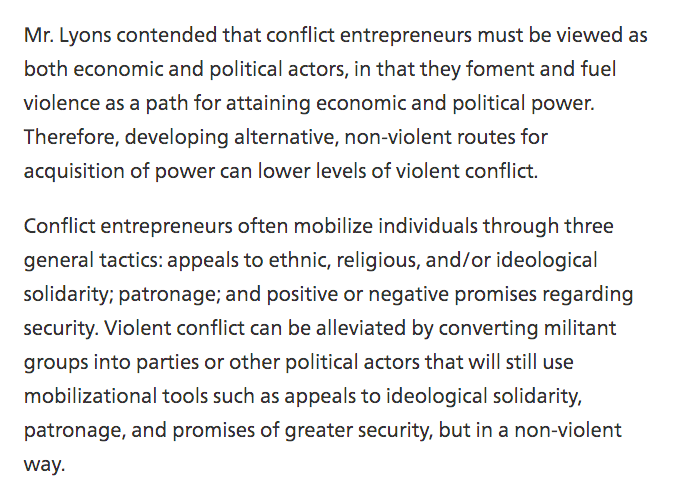


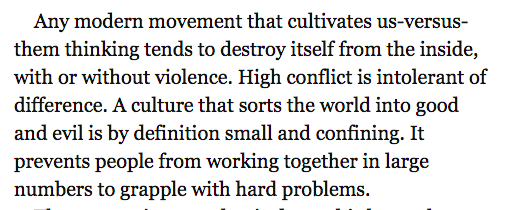
 Does not collapse into dehumanization. https://abs.twimg.com/emoji/v2/... draggable="false" alt="🚨" title="Polizeiautos mit drehendem Licht" aria-label="Emoji: Polizeiautos mit drehendem Licht"> Also known as healthy conflict.” (emojis mine)" title="24. She defines good conflict as “friction that can be serious and intense but leads somewhere useful. https://abs.twimg.com/emoji/v2/... draggable="false" alt="🚨" title="Polizeiautos mit drehendem Licht" aria-label="Emoji: Polizeiautos mit drehendem Licht"> Does not collapse into dehumanization. https://abs.twimg.com/emoji/v2/... draggable="false" alt="🚨" title="Polizeiautos mit drehendem Licht" aria-label="Emoji: Polizeiautos mit drehendem Licht"> Also known as healthy conflict.” (emojis mine)">
Does not collapse into dehumanization. https://abs.twimg.com/emoji/v2/... draggable="false" alt="🚨" title="Polizeiautos mit drehendem Licht" aria-label="Emoji: Polizeiautos mit drehendem Licht"> Also known as healthy conflict.” (emojis mine)" title="24. She defines good conflict as “friction that can be serious and intense but leads somewhere useful. https://abs.twimg.com/emoji/v2/... draggable="false" alt="🚨" title="Polizeiautos mit drehendem Licht" aria-label="Emoji: Polizeiautos mit drehendem Licht"> Does not collapse into dehumanization. https://abs.twimg.com/emoji/v2/... draggable="false" alt="🚨" title="Polizeiautos mit drehendem Licht" aria-label="Emoji: Polizeiautos mit drehendem Licht"> Also known as healthy conflict.” (emojis mine)">
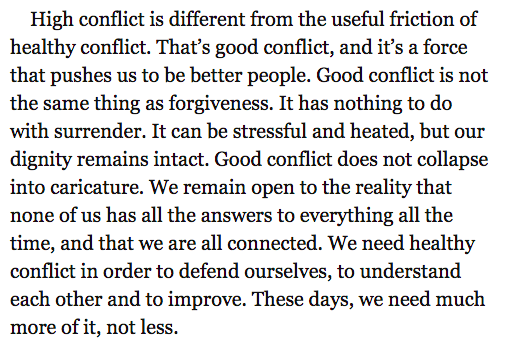 Does not collapse into dehumanization. https://abs.twimg.com/emoji/v2/... draggable="false" alt="🚨" title="Polizeiautos mit drehendem Licht" aria-label="Emoji: Polizeiautos mit drehendem Licht"> Also known as healthy conflict.” (emojis mine)" title="24. She defines good conflict as “friction that can be serious and intense but leads somewhere useful. https://abs.twimg.com/emoji/v2/... draggable="false" alt="🚨" title="Polizeiautos mit drehendem Licht" aria-label="Emoji: Polizeiautos mit drehendem Licht"> Does not collapse into dehumanization. https://abs.twimg.com/emoji/v2/... draggable="false" alt="🚨" title="Polizeiautos mit drehendem Licht" aria-label="Emoji: Polizeiautos mit drehendem Licht"> Also known as healthy conflict.” (emojis mine)">
Does not collapse into dehumanization. https://abs.twimg.com/emoji/v2/... draggable="false" alt="🚨" title="Polizeiautos mit drehendem Licht" aria-label="Emoji: Polizeiautos mit drehendem Licht"> Also known as healthy conflict.” (emojis mine)" title="24. She defines good conflict as “friction that can be serious and intense but leads somewhere useful. https://abs.twimg.com/emoji/v2/... draggable="false" alt="🚨" title="Polizeiautos mit drehendem Licht" aria-label="Emoji: Polizeiautos mit drehendem Licht"> Does not collapse into dehumanization. https://abs.twimg.com/emoji/v2/... draggable="false" alt="🚨" title="Polizeiautos mit drehendem Licht" aria-label="Emoji: Polizeiautos mit drehendem Licht"> Also known as healthy conflict.” (emojis mine)">
